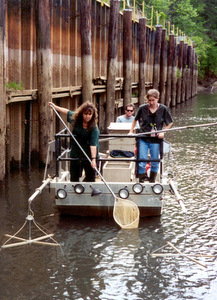Ecological and Human Health Evaluation, Buffers Zones, and Stakeholder Collaboration
 ARCHIVED DEC 2018
ARCHIVED DEC 2018
Investigators: J. Burger (Rutgers) and M. Gochfeld (UMDNJ-Robert Wood Johnson Medical School).
Project Objectives: To provide DOE with (i) ecological data relevant to protection of human health and the environment before, during, and after remediation, (ii) ecological data on buffers and their relationship to land use, energy facilities, and NERPS, (iii) templates for ecological data needed for protection of human health and the environment following cleanup and closure, and (iv) data on the ecological resources to be protected and evaluated (biomonitoring plans) following closure at DOE’s major sites.
Our overall goals are:
- To examine whether the buffers that exist at the large DOE sites are sufficient to allow diverse future land uses to coexist (for example, energy facilities, NERPS, protection of residual hazardous wastes, and assurance of adequate security).
- To investigate the relationship between public perceptions of ecological resources, eco-cultural values, and development of NERPs and energy facilities on DOE lands.
- To provide suggested approaches that could be used to integrate Native American eco-cultural and ecological values with multiple uses of buffer zones.
- To develop suggested approaches that could potentially be used to create ecological monitoring for long-term protection of human health and the environment.

Relevance and Impact to DOE: DOE is faced with the largest environmental remediation and restoration task in the US, and to accomplish this goal, DOE must be able to assure the public that it can protect human health and the environment, that suitable future land uses are in place, and that appropriate monitoring plans provide assurances of environmental protection. Regulatory approval of either area-wide or site closure are likely to depend on the robustness of long-term stewardship plans that link remediation completion with such plans and their effective implementation. Such assurances are not possible unless all parties (regulators, governmental agencies, scientists, Tribal Nations, environmental groups, the public, and others) can reach a general agreement, preferably consensus, about the data needs, evaluations and assessment, buffer zone sizes, monitoring plans, and paths forward. For DOE to move forward with cleanup and closure, there must be suitable conceptual models, sufficient ecological and exposure information, templates of needed data, understanding of baseline risk assessments and screening risk assessments, and data to design monitoring plans that will allow stakeholders, and where applicable tribal groups, to accept remediation and closure plans.
This project will examine the informational needs and data gaps that relate to ecological systems and resources their relationship to human health and Native American concerns, using the major DOE sites (Hanford, SRS, Oak Ridge, and INL). It will examine site-specific information on the use of buffer areas for multiple purposes (ecological protection, Tribal resource needs, energy facilities, NERPS, protection around remaining contaminants). Further, understanding appropriate buffer lands (sizes, spatial distribution), developing templates for data needs and uncertainties, integrating ecological assessments with stakeholder concerns and perceptions, and evaluating ecological resources in terms of the needs of the range of stakeholders will lead to melding the protection of ecological health and the environment with remediation, restoration, and long-term stewardship (including targeted monitoring).